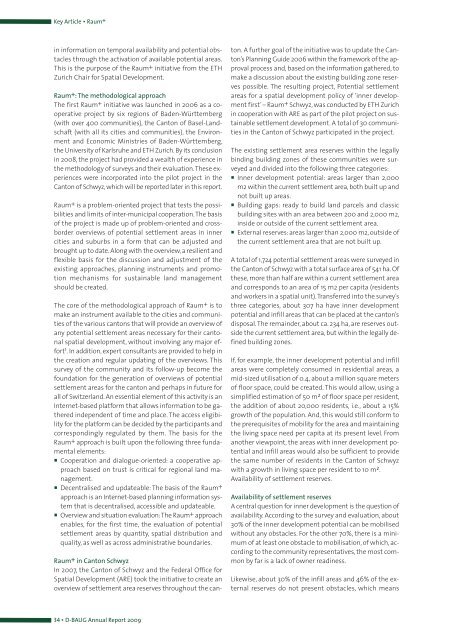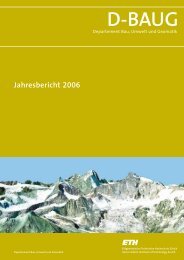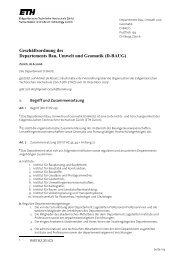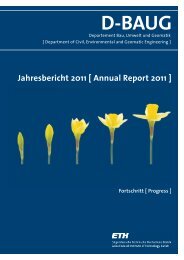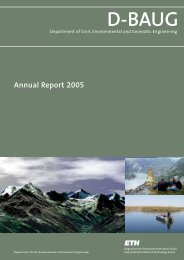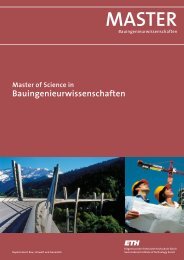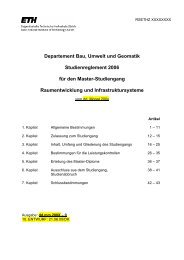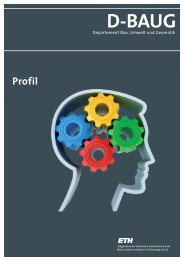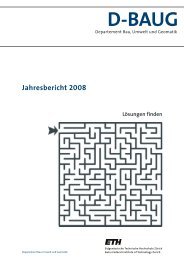D-BAUG - Departement Bau, Umwelt und Geomatik - ETH Zürich
D-BAUG - Departement Bau, Umwelt und Geomatik - ETH Zürich
D-BAUG - Departement Bau, Umwelt und Geomatik - ETH Zürich
Create successful ePaper yourself
Turn your PDF publications into a flip-book with our unique Google optimized e-Paper software.
Key Article ▪ Raum +<br />
in information on temporal availability and potential obstacles<br />
through the activation of available potential areas.<br />
This is the purpose of the Raum+ initiative from the <strong>ETH</strong><br />
Zurich Chair for Spatial Development.<br />
Raum+: The methodological approach<br />
The first Raum+ initiative was launched in 2006 as a cooperative<br />
project by six regions of Baden-Württemberg<br />
(with over 400 communities), the Canton of Basel-Landschaft<br />
(with all its cities and communities), the Environment<br />
and Economic Ministries of Baden-Württemberg,<br />
the University of Karlsruhe and <strong>ETH</strong> Zurich. By its conclusion<br />
in 2008, the project had provided a wealth of experience in<br />
the methodology of surveys and their evaluation.These experiences<br />
were incorporated into the pilot project in the<br />
Canton of Schwyz, which will be reported later in this report.<br />
Raum+ is a problem-oriented project that tests the possibilities<br />
and limits of inter-municipal cooperation.The basis<br />
of the project is made up of problem-oriented and crossborder<br />
overviews of potential settlement areas in inner<br />
cities and suburbs in a form that can be adjusted and<br />
brought up to date. Along with the overview, a resilient and<br />
flexible basis for the discussion and adjustment of the<br />
existing approaches, planning instruments and promotion<br />
mechanisms for sustainable land management<br />
should be created.<br />
The core of the methodological approach of Raum+ is to<br />
make an instrument available to the cities and communities<br />
of the various cantons that will provide an overview of<br />
any potential settlement areas necessary for their cantonal<br />
spatial development, without involving any major effort<br />
1 . In addition, expert consultants are provided to help in<br />
the creation and regular updating of the overviews. This<br />
survey of the community and its follow-up become the<br />
fo<strong>und</strong>ation for the generation of overviews of potential<br />
settlement areas for the canton and perhaps in future for<br />
all of Switzerland. An essential element of this activity is an<br />
Internet-based platform that allows information to be gathered<br />
independent of time and place. The access eligibility<br />
for the platform can be decided by the participants and<br />
correspondingly regulated by them. The basis for the<br />
Raum+ approach is built upon the following three f<strong>und</strong>amental<br />
elements:<br />
� Cooperation and dialogue-oriented: a cooperative approach<br />
based on trust is critical for regional land management.<br />
� Decentralised and updateable: The basis of the Raum+<br />
approach is an Internet-based planning information system<br />
that is decentralised, accessible and updateable.<br />
� Overview and situation evaluation:The Raum+ approach<br />
enables, for the first time, the evaluation of potential<br />
settlement areas by quantity, spatial distribution and<br />
quality, as well as across administrative bo<strong>und</strong>aries.<br />
Raum+ in Canton Schwyz<br />
In 2007, the Canton of Schwyz and the Federal Office for<br />
Spatial Development (ARE) took the initiative to create an<br />
overview of settlement area reserves throughout the can-<br />
34 ▪ D-<strong>BAUG</strong> Annual Report 2009<br />
ton. A further goal of the initiative was to update the Canton’s<br />
Planning Guide 2006 within the framework of the approval<br />
process and, based on the information gathered, to<br />
make a discussion about the existing building zone reserves<br />
possible. The resulting project, Potential settlement<br />
areas for a spatial development policy of ‘inner development<br />
first’ – Raum+ Schwyz, was conducted by <strong>ETH</strong> Zurich<br />
in cooperation with ARE as part of the pilot project on sustainable<br />
settlement development. A total of 30 communities<br />
in the Canton of Schwyz participated in the project.<br />
The existing settlement area reserves within the legally<br />
binding building zones of these communities were surveyed<br />
and divided into the following three categories:<br />
� Inner development potential: areas larger than 2,000<br />
m2 within the current settlement area, both built up and<br />
not built up areas.<br />
� Building gaps: ready to build land parcels and classic<br />
building sites with an area between 200 and 2,000 m2,<br />
inside or outside of the current settlement area.<br />
� External reserves: areas larger than 2,000 m2, outside of<br />
the current settlement area that are not built up.<br />
A total of 1,724 potential settlement areas were surveyed in<br />
the Canton of Schwyz with a total surface area of 541 ha. Of<br />
these, more than half are within a current settlement area<br />
and corresponds to an area of 15 m2 per capita (residents<br />
and workers in a spatial unit).Transferred into the survey’s<br />
three categories, about 307 ha have inner development<br />
potential and infill areas that can be placed at the canton’s<br />
disposal.The remainder, about ca. 234 ha, are reserves outside<br />
the current settlement area, but within the legally defined<br />
building zones.<br />
If, for example, the inner development potential and infill<br />
areas were completely consumed in residential areas, a<br />
mid-sized utilisation of 0.4, about a million square meters<br />
of floor space, could be created. This would allow, using a<br />
simplified estimation of 50 m² of floor space per resident,<br />
the addition of about 20,000 residents, i.e., about a 15%<br />
growth of the population. And, this would still conform to<br />
the prerequisites of mobility for the area and maintaining<br />
the living space need per capita at its present level. From<br />
another viewpoint, the areas with inner development potential<br />
and infill areas would also be sufficient to provide<br />
the same number of residents in the Canton of Schwyz<br />
with a growth in living space per resident to 10 m².<br />
Availability of settlement reserves.<br />
Availability of settlement reserves<br />
A central question for inner development is the question of<br />
availability. According to the survey and evaluation, about<br />
30% of the inner development potential can be mobilised<br />
without any obstacles. For the other 70%, there is a minimum<br />
of at least one obstacle to mobilisation, of which, according<br />
to the community representatives, the most common<br />
by far is a lack of owner readiness.<br />
Likewise, about 30% of the infill areas and 46% of the external<br />
reserves do not present obstacles, which means


